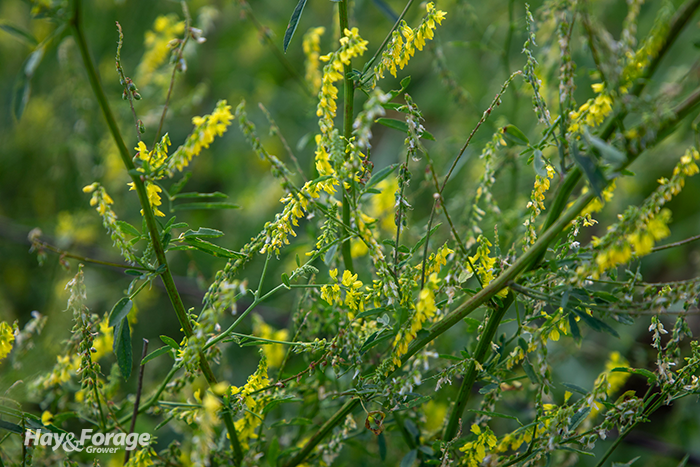
Many forages have their trade-offs, whether those be related to growth patterns, harvest management, storage considerations, or feeding precautions. Some examples include the summer slump in cool-season grass growth, bloat risk in grazed legumes, prussic acid poisoning in members of the sorghum family, and tall fescue toxicosis. Despite these disorders, the forages still have positive attributes to offer hay and livestock production.
Sweetclover is no exception.
Sweetclover is a biennial legume that tends to pop up in pastures and hayfields during its second growth year when afforded enough precipitation. Where it is present, it can be a nutritious addition to grazed and harvested forage, providing a good source of energy and having a protein content similar to that of alfalfa.
With that said, Aaron Berger reminds farmers of the trade-offs of sweetclover in a recent article from University of Nebraska Extension. Although the yellow- or white-flowered legume can make for excellent feed, the extension educator explains that it can cause bloat when grazed. More importantly, sweetclover hay can become toxic when it gets moldy.
Beware of wet hay
Grazing sweetclover has not shown to cause any other health issues in livestock besides the risk of bloat, which can be higher or lower depending on grazing management and growing conditions.
“Cattle can adapt to grazing forage with high bloat potential over a period of several days,” Berger writes. “Where problems occur is usually when cattle are hungry and turned into a pasture where sweetclover is immature and in abundance. Wet or moist conditions can also trigger a bloat event.”
A greater concern lies in moldy sweetclover hay.
Sweetclover is named for the presence of coumarin in the forage because when plants are cut, the substance emits a sweet, vanilla-like odor. However, if hay containing sweetclover is put up too wet, coumarin is converted to dicoumarol by a fungus in moldy forage. Dicoumarol is an anti-clotting agent that inhibits vitamin K production in livestock and can cause cattle to hemorrhage severely, causing death from internal bleeding. Berger notes warfarin, an ingredient found in rat poison, works similarly to dicoumarol.
According to Krista Ehlert, an assistant professor and extension range specialist with South Dakota State University, the conversion of coumarin to dicoumarol can occur even if there is only a little mold in hay. In other words, mold level is not a good indicator of the potential risk of sweetclover poisoning.
The best way to prevent high levels of dicoumarol in sweetclover hay is to ensure forage is sufficiently dry before baling; however, sweetclover stems are notably thick and difficult to dry down to levels acceptable for baling. With that said, there are some mitigation strategies to avoid sweetclover poisoning.
Ehlert recommends cutting forage when sweetclover is relatively immature. At this point, stems will not be as thick and dry down faster. On the other hand, Berger suggests avoiding areas of the hayfield that are heavily populated with sweetclover and waiting to cut these patches until sweetclover has fully matured and standing forage begins to dry down.
In any case, avoid making large, dense bales, if possible. Doing so can exacerbate spoilage if forage is slightly wet, and damp hay will be the most prone to mold formation, especially at the core of the bale.
Feeding risks
Even when farmers take precautions during harvest, dicoumarol may still linger in stored forage and pose a threat to livestock during feedout.
Berger recommends alternating feeding hay that contains sweetclover with other feeds. “A recommended strategy is to feed hay with sweetclover for two weeks and then feed safe forage for two weeks,” he writes. “At the end of the two weeks, begin the rotation again. This intermittent feeding strategy is safer than mixing safe forage with moldy sweetclover hay.”
Stop feeding sweetclover hay at least three weeks before the start of calving season. Moreover, refrain from feeding sweetclover hay prior to any surgical procedures like dehorning or castration. Of course, testing hay and requesting a dicoumarol analysis will help evaluate your risk; however, it can be challenging to take a sample that contains a representative amount of mold.
Ehlert notes that there have been reports of the presence of dicoumarol in hay causing reproduction problems in cattle. She explains that dicoumarol can pass into the fetus of a pregnant cow and result in abortion. “This is more of a problem in later gestation during the winter when pregnant cows are consuming sweetclover hay,” she writes in a South Dakota State University Extension article.
Although sweetclover poisoning can occur in silage, it is less likely to happen when fermentation process is completed quickly and efficiently, mitigating the risk of mold growth. Likewise, making baleage may be a solution to baling hay that contains sweetclover during a wet year.
Ehlert reiterates that grazing sweetclover should be a nonissue. She explains that the conversion of coumarin to dicoumarol is not possible without the mold fungus that develops in wet hay. Moreover, research from the USDA Poisonous Plant Research Laboratory in Utah shows there is nothing to suggest cattle on pastures containing sweetclover during the breeding season will develop issues with fertility or conception.
Therefore, sweetclover isn’t necessarily a detriment to pasture and hayfields, but it must be carefully managed where present to take advantage of its nutritional benefits.
“Sweetclover is an opportunistic plant that takes advantage of good growing conditions when they are available,” Berger writes. “In grazing situations, it can be a good feed resource. When harvesting as hay, use caution in both putting it up and feeding it.”

